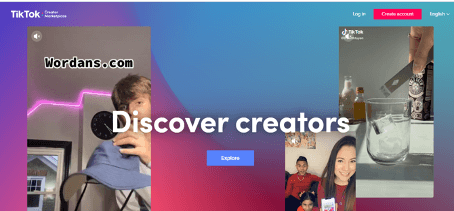Will influencer campaigns become part of your marketing focus for 2022? If so, it’s essential to keep an eye on the latest trends in your industry. The good news is more users are shopping on social media. In fact, experts believe the social commerce industry will reach $80 billion by 2025.
Consider certain factors to get the best influencer campaign results. Is Instagram supporting content creators? Should you focus on video content instead of graphics or images? This is why brands are working more closely with micro-influencers. They’re niche-specific and can be more targeted.
Curious to learn more? Here are the latest influencer marketing trends to watch for in 2022.
1. Marketplaces for Creators and Brands

TikTok launched a platform called Creator Marketplace to make it easy for brands and creators to collaborate. Instagram also jumped on the bandwagon by introducing a new suite of tools that helps creators and companies connect and create new partnerships.
Since the release of these new platforms, small-business owners have had the opportunity to streamline communication with influencers. Marketing experts believe the platforms themselves will cause a shift in the influencer marketing agency space. Agencies will possibly decrease due to the ease of discoverability and collaborations on one platform. While that is just an opinion, it’s certainly a trend to keep in mind.
2. Nano and Micro-Influencers
Influencers are often known as social media celebrities because they have millions of followers. However, massive followings are no longer as significant for making product recommendations.
Nano and micro-influencer partnerships are the latest collaboration trends for most brands. They’re excellent for influencing buyer decisions because they have a highly refined audience and niche community.

Forever 21, a fast-fashion brand, partnered with plus-size micro-influencer Kristal Heredia who raises awareness about Forever 21’s plus-size brand. These days, consumers are drawn to authenticity. They’d rather take recommendations from friends and trusted associates.
Aside from that, the algorithm benefits those with fewer followers because they have higher engagement on their content. Shifting to a micro-influencer may have a better impact on your campaign results.
3. The Growth of Video Content
TikTok and Instagram Reels are gaining popularity. Short videos are highly engaging for niche communities. With that in mind, influencer marketing in this area should be the focus for small businesses in 2022.
The best way to approach video is to stay flexible with your content strategy. Allow creator partners to use their creativity. TikTok and Instagram reward genuineness. Audiences turn away from perfectly polished content. Focus on engaging by providing valuable and relevant content as a way to connect with your community.
4. Influencers as Entrepreneurs
One of the latest influencer marketing trends is the full-on creation of business owners. While influencing can be a full-time job in itself, some are also launching their own companies. For example, Elanna McGowan, a beauty influencer, recently launched her brand on Instagram.

This is good news for brands is this opens a new wave of opportunities for partnerships. Connect with these influencers to see if you can collaborate for a giveaway. If it makes sense to leverage their new brand, it’s a win-win.
5. Long-Lasting Influencer Partnerships
Brands are investing in long-term influencer relationships. There will always be a spot for one-off marketing partnerships, but companies are more likely to create authentic connections with their audiences through ambassador programs. These partnerships leverage influencer expertise that builds credibility over time.
Driving a long-term brand partnership could be the next move in your business. When influencers continuously promote different aspects of their collaboration, they deepen positive brand associations. In turn, this drives action and increases brand loyalty.
6. The Rise of Representation
Social activists spotted a lack of diversity in the influencer industry in 2020. Influencers called out many brands for this and unfair pay. As a result, creators decided to speak up and highlight that there needed to be more representation in influencer marketing.
The influencer community is changing — and while diversity and inclusion should never be a trend, brands also need to embed this in their work and company culture.
7. Reposting User-Generated Content
User-generated content (UGC) is an excellent marketing strategy many companies use. It’s perceived as trustworthy compared to branded advertising. It can help build the credibility of your products and the bulk of enticing content.

Instead of traditional advertising, Lush completely replaced it with user-generated content images of their products. This is suitable since influencer marketing is a great way to connect with millennials and Gen Z who are consumers of their products.
However, the legality surrounding UGC reposts remains a mystery. There’s anticipation for more conversations around this. For instance, some creators ask for credit within the first two lines of a caption rather than at the bottom. This is a growing trend that speaks to the shift of content creation. People want to ensure they get credited above the fold.
8. Influencer Marketing Is Growing for the B2B Community
B2B influence is expected to grow by 40%-50% this year. Influence is founded on the trust between a brand and its audience. Three elements make up the balance of that foundation:
- Authenticity: Showing the true you
- Logic: The reasoning behind what you say
- Empathy: Showing you care about others’ success
B2Bs must engage this in their strategy. Most of the time, though, B2B content is based on logic rather than empathy. In turn, it can lack connection because it relies too heavily on research.
More B2B brands are testing their influence by balancing empathy into the mix. Consider one strategy that devises four dimensions to assess your performance:
- Expertise: Your audience trusts your knowledge and solutions to their problems.
- Empathy: Your audience perceives you as an ally and establishes a positive relationship with your brand.
- Practicality: Your audience feels confident that you can solve their specific problems.
- Brand strength: Your audience will want to work with you and feel comfortable with the association.
One Final Consideration
Social media has become a highly valuable platform for brands and creators. The ongoing pandemic has dramatically impacted e-commerce sales growth and the marketing landscape. 2022 will likely be the time for brands and influencers to create authentic connections and shine.
Although there can be challenges to influencer marketing, there can also be many benefits. Take note of these influencer marketing trends and strongly consider incorporating them into your potential strategies — wherever it makes sense.





